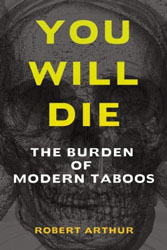Posted: October 5th, 2011 | Filed under: addiction, alcohol, amphetamine, cocaine, drugs, gambling, marijuana, tobacco | 2 Comments »
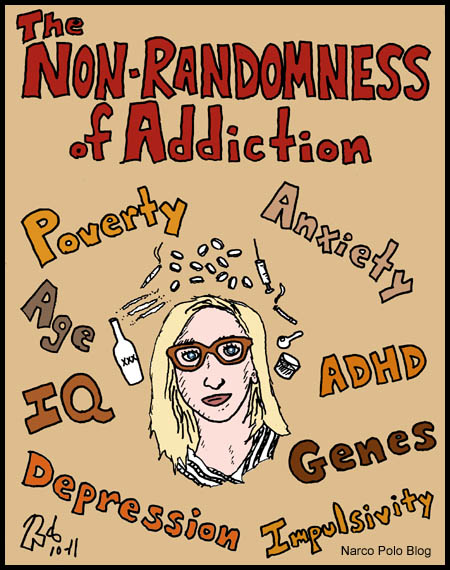
A tenet of the drug war is that drug X is so pleasurable that once tried, most people cannot resist it. There is no way of knowing if you have the “disease” of lifelong addiction to drug X, therefore no one should ever try drug X. All of this is wrong.
The vast majority of people who try drugs do not go on to become addicted (1, 9), and those that do tend to share certain characteristics and conditions. Here are some of the things that predispose people to addiction:
Other Addictions
If a person has not been able to exercise self-control with one source of pleasure, it is more likely he or she will not be able to exercise self-control with another source of pleasure. As can be seen in the following chart, someone diagnosed with a cocaine dependence is 6.64 times more likely than someone without a cocaine dependence to develop a dependence to alcohol.
 (6)
(6)
This overindulgence is not reserved to drugs as demonstrated by the considerable overlap of drug addictions and behavioral addictions. Note that the percentage of the general population that has ever experienced substance use disorders is 14.6%. (5)
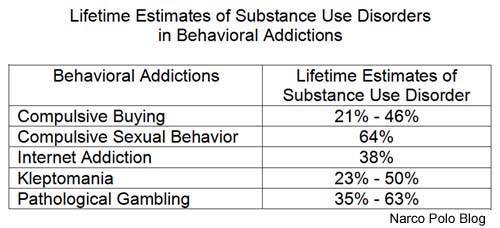 (2)
(2)
Although overlap with food addiction is complicated by drugs’ effects on weight (e.g. cigarettes and stimulants suppress appetites), 32.6% of weight-loss surgery candidates have experienced substance use disorders. (4)
Poverty
Surveys of drinking have long found that despite being more likely to abstain, those from lower socioeconomic groups are still “much more often” problem drinkers. (10, p. 160) A more recent study has found income serves as a predictor for more than just alcohol dependence. As seen below, people in the poorest income bracket are almost three times as likely to become dependent on cocaine as those in the wealthiest bracket.
 (6)
(6)
Mental Health Issues
People with mental health issues are more likely than their peers to become addicted to substances. As can be seen below those diagnosed with ADHD or a personality disorder are three times as likely to become dependent on alcohol.
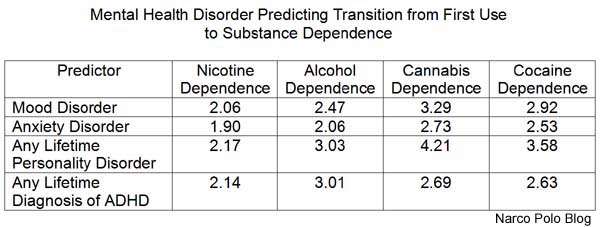 (6)
(6)
Lower Intelligence
Heavy drug users frequently score lower on cognitive tests than their peers. This has been used to say drugs lower intelligence. In the early 2000s two twin studies disproved this idea. In these studies one twin had a history of drug abuse and the other did not. Neither study found a correlation between cognitive performance and amount of drug use. The studied drugs were marijuana, cocaine, and amphetamine. Lower cognitive abilities lead to heavy drug use, not vice versa. (3, pp. 150-152)
Genes
An adoption study has shown that the biological father’s drinking patterns predict a son’s alcoholism, while the adoptive father’s does not. Boys whose biological fathers were severe alcoholics had an alcoholism rate of 18% with an alcoholic adoptive father, 17% with an adoptive home free of parental alcoholism. A study of twins found shared genes did not correlate with experimentation with illicit drugs, but if an identical twin was dependent there was a 40% chance the twin was also dependent. (3, p. 92)
Addictive Personality
People with substance use disorders, just like people with behavioral addictions, score high on self-report measures for sensation-seeking and impulsivity, and low for harm avoidance. (2) This is not surprising. An addict is arguably someone who chooses the sensation an activity provides at levels that are harmful. The choice is influenced by his or her impulsivity, i.e. the tendency to act without weighing the future consequences of one’s actions. The pleasure an addictive behavior provides is immediate whereas the pleasure of moderation is often distant and abstract (e.g. long-term health, more stable work/family life).
Youth
Not only are older people much less likely to become dependent on something, they are also more likely to end dependencies. The vast majority of addicts “mature out” of their addictions and most of them accomplish this without treatment. (11, p. 13) Maturing out is so pervasive that a national 2010 survey found that only .1% of people 65 or older had abused or been dependent on an illegal substance in the past year. The highest level was reached by 19-year-olds (9.3%) from which the number decreased with each ensuing age category. (8)
 (6)
(6)
In line with this, addictive personalities weaken over time. Older adults report being less impulsive, sensation-seeking, and risk tolerant than their younger peers. (12)
Conclusion
Addiction is an intense involvement people fall into for solace when they cannot find better gratifications in the rest of their lives. (11, p. 16) The escape provided by destructive behaviors is usually only appealing to those suffering from internal sources, e.g. mental health issues, or external sources, e.g. poverty. Addiction is a symptom of underlying problems. This helps explain why, contrary to the exhortations of America’s drug warriors, the legal status of drugs has been found to have “surprisingly little measurable consequence” on factors like addiction rates. (7, 3, p. 3) The locus of addiction lies in people, not substances.
Sources
1. Robert Arthur, You Will Die: The Burden of Modern Taboos, 3rd Ed. (2008), p. 330.
2. Jon Grant, et al., “Introduction to Behavioral Addictions,” American Journal of Drug and Alcohol Abuse, 36, 2010.
3. Gene Heyman, Addiction: A Disorder of Choice (2009).
4. Melissa Kalarchian, et al., “Psychiatric Disorders Among Bariatric Surgery Candidates,” American Journal of Psychiatry, Feb. 2007. LINK
5. Ronald Kessler, et al., “Lifetime Prevalence and Age-of-Onset Distributions of DSM-IV Disorders in the National Comorbidity Survey Replication,” Archives of General Psychiatry, 62, 2005.
6. Catalina Lopez-Quintero, et al., “Probability and Predictors of Transition from First Use to Dependence ….,” Drug and Alcohol Dependence, 115, 2011.
7. Robert MacCoun and Peter Reuter, Drug War Heresies (2001), pp. 236-237.
8. “National Survey on Drug Use and Health,” Fig. 5.3B, Substance Abuse and Mental Health Services Administration (SAMHSA), 2010. LINK
9. Frank Owen, No Speed Limit (2007), p. 48.
10. Stanton Peele, Diseasing of America (1995), p. 160.
11. Stanton Peele, Seven Tools to Beat Addiction (2004).
12. D.R. Roalf, et al., “Risk, Reward, and Economic Decision Making in Aging,” Journals of Gerontology, 6 Sep. 2011. LINK
Posted: March 12th, 2010 | Filed under: cocaine, drugs | 6 Comments »
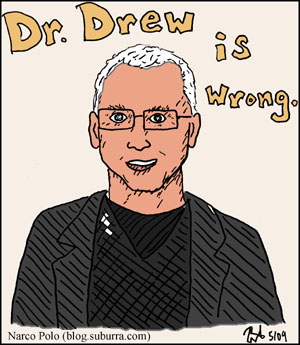 Dr. Drew Pinsky frequently enjoyed cocaine while working at the LA radio station, KROQ, in the early 1980s. This was asserted by two of his former KROQ co-workers earlier this year in this article, “Dr. Drew’s Drug Shocker!”. This allegation is not shocking because at the time cocaine use was commonplace in the LA entertainment industry.
Dr. Drew Pinsky frequently enjoyed cocaine while working at the LA radio station, KROQ, in the early 1980s. This was asserted by two of his former KROQ co-workers earlier this year in this article, “Dr. Drew’s Drug Shocker!”. This allegation is not shocking because at the time cocaine use was commonplace in the LA entertainment industry.
It is also unsurprising that Pinksy would have been like the vast majority of cocaine users who enjoy it for a period and then stop using it. No addiction. No dreaded consequences. Responsible users include our last two presidents, but unlike our last two presidents Pinsky may have lied about his usage.
On the January 12, 2009 Howard Stern Show this interchange occurred:
Howard Stern: Were you ever a user of drugs?
Drew Pinsky: No.
Howard Stern: Never? Never tried pot? Nothing?
Drew Pinsky: Thank god it’s not in me. It doesn’t seem like anyway. I’m thinking – not good.
Robin Quivers: Do you feel you can’t really relate because you don’t have any experience?
Drew Pinsky: No. I can. In fact people in recovery always tell me that it is weird how much I understand it. They don’t understand how a non-recovery person has such a deep appreciation of this condition. I don’t know. It’s like the right side of my brain is overdeveloped and I can just tune into that.
Dr. Drew has not addressed the KROQ allegation. The fact that the most celebrated addiction doctor in America may have lied about his cocaine use will pass unnoticed. Dishonesty has always been an approved strategy in the war on drugs.
Prior Post on Dr. Drew Pinsky: Dr. Drew Is Wrong
Sources:
1. “Dr. Drew’s Drug Shocker!” LifeandStyleMag.com, 13 Jan. 2010. LINK
2. Gary Dell’Abate, The Howard Stern Show, Sirius XM Radio, 12 Jan. 2009.
Posted: November 30th, 2009 | Filed under: amphetamine, cocaine, drugs, LSD, marijuana, media bias | 4 Comments »
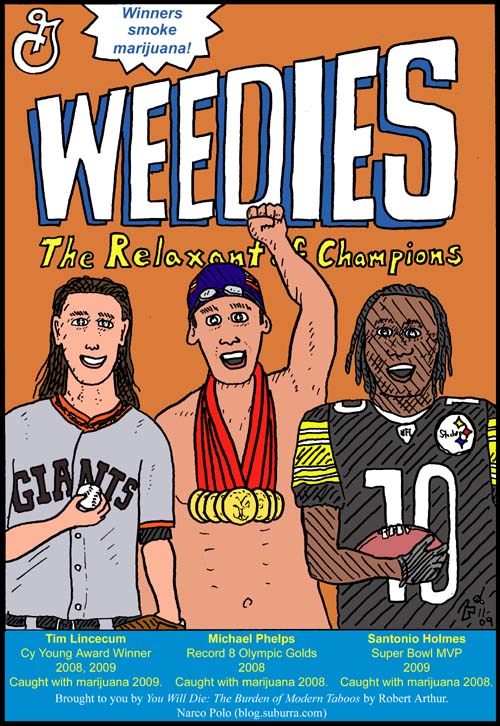
World class athletes have been caught using recreational drugs for years but what makes the recent cases of Tim Lincecum, Michael Phelps, and Santonio Holmes remarkable is that they have been outed at the peak of their careers. In these three instances, law enforcement has helped obliterate the mainstream myth that marijuana smokers cannot be overachievers in amazing physical conditions.
They All Do It
Rob Dibble, an all-star pitcher who played in the late 1980s and early 1990s, estimated that teams he played for varied from 20-60% in marijuana usage rates. In the late 1990s a New York Times investigation estimated the marijuana usage rate of players in the NBA to be at 60-70%. (A figure Josh Howard reasserted in 2008, LINK.)
Of course, the New York Times piece portrayed this as a sign “the party life style associated with the game is spinning out of control.” It then interviewed NBA players like Derek Harper who said it was “scary” because you might be playing against a guy on drugs and not know it, and Karl Malone who thought fans had a right to know if the players used recreational drugs and that privacy concerns about testing were ridiculous because, “you have too many knuckleheads out there, too many guys doing crazy things without realizing the consequences.”
Those Consequences
There is a strong case that – just like with alcohol – the moderate use of marijuana and other recreational drugs in one’s free time has little or no effect on performance. Professional athletics is hyper-competitive. As soon as you lose a step to the countless competitors behind you, you are gone. If marijuana use impeded performance it is doubtful the usage rates would be so high with million dollar salaries at stake.
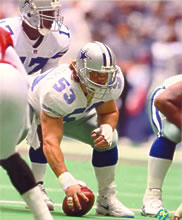 Mark Stepnoski (pictured) played 13 seasons in the NFL as a center winning two Super Bowls and going to five pro bowls. He smoked marijuana throughout his college and professional career saying, “To me it’s all about responsibility. There’s a time and a place for everything.”
Mark Stepnoski (pictured) played 13 seasons in the NFL as a center winning two Super Bowls and going to five pro bowls. He smoked marijuana throughout his college and professional career saying, “To me it’s all about responsibility. There’s a time and a place for everything.”
Stepnoski, who is now a marijuana legalization activist, has also pointed out his Super Bowl coach, Jimmy Johnson, had a different theory than Karl Malone.
As long as you did your job for him and did it well, he wasn’t going to snoop into what you were doing the rest of the time. It wasn’t his responsibility to be your parent or your guardian or anything else.
Despite the New York Times dire warning in the late 1990s the NBA is still thriving.
Other Notable Outed Athletes
NFL
Randy Moss (WR) – In high school spent a week in solitary confinement for smoking marijuana. Was kicked out of Florida State for smoking marijuana. Caught with marijuana by law enforcement in 2001. Tested positive for marijuana in the NFL in 2002. Implied was still smoking marijuana in 2005. In 1998 broke rookie NFL record for touchdown catches in a season. In 2007 broke NFL record for touchdown catches in a season.
Others: Kevin Faulk (caught at a Lil Wayne concert with marijuana in 2008), Percy Harvin, Michael Irvin, Curtis Johnson, Marshawn Lynch, Mario Manningham, Amobi Okoye, Lawrence Taylor, Ricky Williams
Link to a dozen NFL players caught with possession since 2008.
NBA
Kareem Abdul Jabbar (C) – In his 20 year career he scored more points than anyone else in the history of the game. Won six MVP awards and six NBA championships. Has been caught with marijuana by law enforcement twice, in 1998 and 2000.
Others: Carmelo Anthony, Mookie Blaylock, Marcus Camby, Josh Howard, Allen Iverson, LeBron James, Shawn Kemp, Vernon Maxwell, Lamar Odom, Robert Parish, Isaiah Rider, Damon Stoudamire, Rasheed Wallace, Chris Webber
MLB
Ferguson Jenkins (P) – Eighteen year veteran won the Cy Young Award in 1971. Was caught with cocaine and marijuana in 1980 and retired in 1983.
Joe Pepitone (OF) – Three time all-star and Gold Glove winner Pepitone wrote in his 1975 memoir that he once shared a joint with Mickey Mantle before a spring training game. Mantle had never had marijuana before. He struck out four times in that game and spent much of his time in the dugout giggling. He told Pepitone, “I don’t know what that shit is, but keep it away from me.”
Others: Dock Ellis, Dwight Gooden, Keith Hernandez (testified that in the early 1980s 40% of MLB players used cocaine), Steve Howe, Paul Molitor, Otis Nixon, Dave Parker, Tim Raines (confessed to sliding into bases head first to avoid breaking the vial of cocaine he kept in his back pocket), Darryl Strawberry, Willie Wilson
Note: Much of the baseball outing in the 1980s stemmed from the Pittsburgh drug trials in which the legendary Willie Stargell was accused of distributing amphetamines by two players on the stand.
Fastest Man In the World
Usain Bolt – In 2009 admitted to smoking marijuana as a kid. LINK
Links of Note:
In 1970 Dock Ellis pitched a no-hitter while on LSD. (Less than 300 have been thrown in Major League Baseball history since 1875.) Here is a great animated short set to him recounting the tale. (Thanks to Chip for tip.)
Hall of Fame baseball player Mike Schmidt discussing how amphetamines, “greenies,” were readily available in baseball clubhouses during his career (1972-1989) – LINK.
Sources:
1. “Outside the Lines: Marijuana in Sports,” ESPN, 24 Feb. 2003. LINK
2. Albert Theodore Powers, The Business of Baseball (2003).
3. Selena Roberts, “Marijuana and Pro Basketball,” New York Times, 26 Oct. 1997. LINK

 (6)
(6) (2)
(2) (6)
(6) (6)
(6) (6)
(6)
 Dr. Drew Pinsky frequently enjoyed cocaine while working at the LA radio station, KROQ, in the early 1980s. This was asserted by two of his former KROQ co-workers earlier this year in this article,
Dr. Drew Pinsky frequently enjoyed cocaine while working at the LA radio station, KROQ, in the early 1980s. This was asserted by two of his former KROQ co-workers earlier this year in this article, 
 Mark Stepnoski (pictured) played 13 seasons in the NFL as a center winning two Super Bowls and going to five pro bowls. He smoked marijuana throughout his college and professional career saying, “To me it’s all about responsibility. There’s a time and a place for everything.”
Mark Stepnoski (pictured) played 13 seasons in the NFL as a center winning two Super Bowls and going to five pro bowls. He smoked marijuana throughout his college and professional career saying, “To me it’s all about responsibility. There’s a time and a place for everything.”